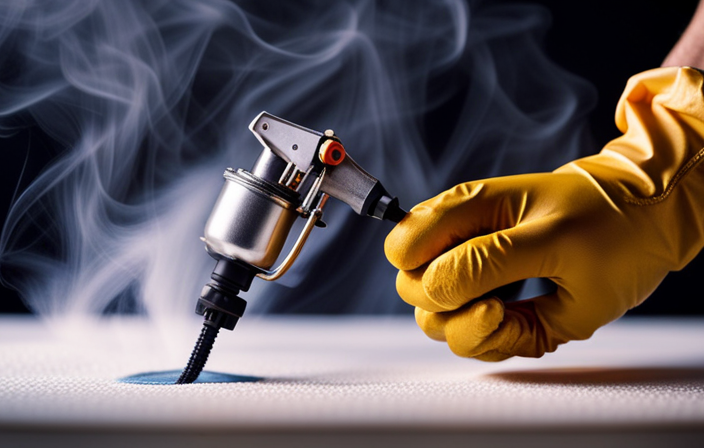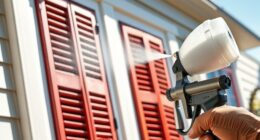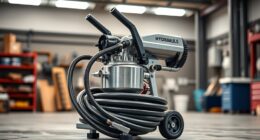Hello everyone! Today, we are going to explore the importance of using a strainer with your airless paint sprayer when using latex paint. You may be wondering why a strainer is necessary for this job. Let me clarify – it can make a significant difference in the outcome.
When it comes to achieving a smooth and flawless finish, a strainer is your best friend. It helps remove any impurities or debris that might be lurking in your paint, ensuring that your sprayer operates at its full potential. Plus, it saves you from those frustrating clogs and uneven application woes. Trust me, I’ve been there.
Now, choosing the right strainer can be a bit overwhelming with all the options out there. But fear not, because I’m here to guide you through the process. We’ll talk about the different types of strainers, considerations for making the right choice, and the benefits of using one.
So, grab a cup of coffee, get comfy, and let’s dive into the world of strainers for airless paint sprayers. You won’t regret it!
Key Takeaways
- Different types of strainers are available for airless paint sprayers, and it is important to choose the right one for latex paint.
- Strainer mesh size should be considered when selecting a strainer for latex paint, with fine mesh being ideal for latex paint.
- Nylon or stainless steel are durable and corrosion-resistant strainer materials that are compatible with latex paint.
- Using a strainer in airless paint sprayers for latex paint improves paint quality, prevents clogs, saves time in cleaning, and ensures a smooth and even application.
Importance of Using a Strainer in Airless Paint Sprayers
You’ll definitely want to use a strainer in your airless paint sprayer for latex paint to ensure a smooth and consistent application. The importance of regular strainer maintenance can’t be overstated. Over time, paint can accumulate debris, such as dried paint flakes or dust particles, which can clog the nozzle and affect the spray pattern. By regularly cleaning and inspecting the strainer, you can prevent these issues and maintain optimal performance.
Additionally, using a fine mesh strainer offers several advantages. The fine mesh helps to filter out even the smallest impurities, ensuring a clean and uniform spray. This results in a professional-looking finish with no visible imperfections.
Now, let’s move on to discussing the different types of strainers for airless paint sprayers.
Different Types of Strainers for Airless Paint Sprayers
When looking for the right filter for your airless paint system, imagine finding a mesh that catches any impurities effortlessly, allowing for a smooth and flawless application.
There are different strainer sizes available for airless paint sprayers, ranging from fine to coarse mesh. The size of the strainer you choose depends on the type of paint you’re using and the desired finish.
Fine mesh strainers are ideal for latex paint as they catch smaller particles, ensuring a smooth and even spray pattern. On the other hand, coarse mesh strainers are better suited for thicker paints, such as oil-based or textured coatings.
Additionally, the best strainer materials are usually made of nylon or stainless steel, as they’re durable and resistant to corrosion. Considering these factors will help you choose the right strainer for your airless paint sprayer setup.
Now, let’s delve into the considerations for choosing the right strainer.
Considerations for Choosing the Right Strainer
When choosing the right strainer for an airless paint sprayer, there are several key considerations to keep in mind. Firstly, the size of the strainer is important as it determines the amount of debris that can be filtered out of the paint.
Secondly, the material of the strainer should be compatible with the type of paint being used, ensuring that it doesn’t react or degrade when in contact with the paint.
Lastly, it’s crucial to select a strainer that’s specifically designed for use with latex paint to ensure optimal performance and prevent clogging issues.
Size of the Strainer
To ensure a flawless finish, choose the right strainer size for your latex paint in an airless paint sprayer. The size of the strainer is important because it determines the amount and size of particles that can pass through.
A strainer that is too small may clog easily, while a strainer that is too large may allow larger particles to pass through and potentially ruin the finish. When selecting the strainer size, consider the viscosity of your latex paint and the desired smoothness of the finish.
Additionally, pay attention to the strainer mesh density, as this will affect the filtration capabilities. By carefully considering the strainer size and mesh density, you can ensure that your airless paint sprayer effectively filters out any unwanted particles, resulting in a professional-looking paint job.
Now, let’s move on to discussing the material of the strainer.
Material of the Strainer
Choose a strainer made from a durable material that effectively filters unwanted particles, ensuring a smooth and professional finish for your project. The material of the strainer is crucial for achieving optimal results with your airless paint sprayer.
One of the main benefits of using a strainer is that it helps to remove any impurities or debris present in the paint, preventing clogs or blockages in the sprayer. Additionally, a high-quality strainer can improve the overall flow of the paint, ensuring a consistent application.
When it comes to compatibility with different types of paint, it’s important to choose a strainer that’s specifically designed for latex paint. This will ensure that the strainer effectively filters out any lumps or clumps, resulting in a smooth and even finish.
Transitioning into the next section, it’s important to understand the compatibility of the chosen strainer with latex paint to achieve the best results.
Compatibility with Latex Paint
Make sure the material of your strainer is compatible with latex paint for the best results. Using a strainer that isn’t compatible with latex paint can cause clogging and affect the spray pattern of your airless paint sprayer.
Latex paint is a popular choice for airless sprayers because it dries quickly, has low odor, and provides a smooth finish. However, latex paint is thicker than other types of paint, so it may need to be thinned before using in an airless sprayer. Follow the manufacturer’s instructions for thinning latex paint to ensure the proper consistency for spraying. Thinning the paint can also help prevent clogging in the sprayer and ensure an even application.
Moving on to the next section about the benefits of using a strainer, it’s important to understand how a strainer can enhance your painting experience.
Benefits of Using a Strainer
Using a strainer in my airless paint sprayer for latex paint has proven to be incredibly beneficial.
First and foremost, it prevents clogging in the spray gun, ensuring a smooth and even flow of paint.
Additionally, it improves the quality of the paint job by removing any potential impurities or debris that could affect the finish.
And perhaps best of all, using a strainer saves me time and effort in cleaning the spray gun afterwards, as it catches any particles that may have otherwise gotten stuck in the nozzle.
Overall, incorporating a strainer into my painting process has been a game-changer, making my projects more efficient and professional-looking.
Prevents Clogging in the Spray Gun
To avoid any pesky blockages in the spray gun, it’s best to opt for a strainer that effortlessly sifts out any potential paint clumps. This not only prevents clogging in the spray gun but also ensures a smooth and uninterrupted paint flow. Using a strainer is an effective way to prevent paint splatters and maintain paint consistency throughout the job. By removing any impurities or debris from the paint, the strainer ensures a clean and even application, improving the overall quality of the paint job. It’s important to choose a strainer with the appropriate mesh size for the type of paint being used. This will ensure that any larger particles or lumps are caught, preventing them from causing issues in the airless paint sprayer. With a reliable strainer in place, you can confidently tackle your painting project without worrying about clogs or uneven results.
Improves the Quality of the Paint Job
The presence of a strainer ensures a clean and even application, resulting in a high-quality paint job with no splatters or inconsistencies. Using a strainer in an airless paint sprayer for latex paint can greatly improve the quality of the paint job. Here are three reasons why:
-
Improving paint adhesion: A strainer removes any impurities or debris from the paint, ensuring that only smooth and consistent paint particles are sprayed onto the surface. This promotes better adhesion of the paint to the surface, resulting in a longer-lasting finish.
-
Reducing paint splatter: The strainer helps to filter out any clumps or chunks in the paint, preventing them from clogging the spray gun. This reduces the chance of paint splattering or spattering during the spraying process, resulting in a cleaner and more professional-looking paint job.
-
Ensuring consistent paint flow: By removing any potential obstructions or contaminants, the strainer ensures a consistent flow of paint through the sprayer. This helps to maintain a steady and even application, preventing any inconsistencies or patchy areas in the finish.
Using a strainer in your airless paint sprayer not only improves the quality of the paint job by enhancing paint adhesion and reducing splatter, but it also saves time and effort in cleaning the spray gun and ensuring a smooth application.
Saves Time and Effort in Cleaning
Now let’s talk about how using the right strainer in your airless paint sprayer can save you time and effort in cleaning. When you use a strainer specifically designed for latex paint, it helps to remove any impurities or debris that may clog the sprayer nozzle. This not only improves the quality of your paint job but also prevents any potential blockages that can disrupt the spraying process.
To ensure smooth operation, it’s important to regularly inspect and clean the strainer. By following some simple strainer maintenance tips, such as rinsing it with warm water after each use and checking for any signs of damage or wear, you can prolong its lifespan and avoid any troubleshooting strainer issues.
Proper strainer maintenance is crucial for optimal performance and will be discussed further in the next section about maintaining your strainer.
Proper Strainer Maintenance
Make sure you’re regularly cleaning and inspecting your strainer to prevent any clogs or debris from affecting the performance of your airless paint sprayer, right? Proper strainer cleaning is essential to maintain the efficiency and longevity of your equipment.
The best practices for strainer maintenance include rinsing the strainer immediately after each use with clean water to remove any paint residue. Use a soft brush to gently scrub away any stubborn particles. It’s also important to check the strainer for any signs of wear or damage and replace it if necessary.
By taking these simple steps, you can ensure that your strainer remains in top condition, allowing for smooth and consistent paint flow. This will set the stage for the subsequent section on the step-by-step guide to using a strainer in airless paint sprayers.
Step-by-Step Guide on Using a Strainer in Airless Paint Sprayers
Before using a strainer in my airless paint sprayer for latex paint, I need to properly prepare the strainer. This involves cleaning it thoroughly to remove any debris or residue that could clog the sprayer.
Once the strainer is clean, I can easily attach it to the paint sprayer, ensuring a secure connection.
When it comes time to strain the latex paint, I simply pour it through the strainer, allowing it to filter out any impurities that could affect the quality of my paint job.
Preparing the Strainer
To properly prepare the strainer for use in your airless paint sprayer with latex paint, make sure you thoroughly clean it and inspect for any signs of damage or clogging.
Start by removing the strainer from its storage and check for any leftover paint residue. Use a brush or a soft cloth to clean the strainer, making sure to remove any debris or particles that may have accumulated. Pay special attention to the mesh, as that’s where the paint will flow through.
After cleaning, inspect the strainer for any signs of damage, such as cracks or holes. If you find any, it’s important to replace the strainer before using it.
Once the strainer is clean and in good condition, you can proceed to attach it to the paint sprayer. This will ensure that the paint flows smoothly and evenly, without any unwanted particles or clogs.
Attaching the Strainer to the Paint Sprayer
Once you’ve finished cleaning and inspecting it, it’s time to attach the strainer to your trusty paint sprayer, ensuring a seamless flow of paint for your next project.
Attaching the strainer is a crucial step in the process, as it helps prevent any debris or impurities from clogging the nozzle and affecting the paint application.
Start by locating the strainer attachment point on your paint sprayer, usually near the paint container or inlet tube. Gently insert the strainer into the attachment point, making sure it fits securely. Some sprayers may require you to twist or lock the strainer in place.
Once attached, double-check that it is firmly in position before proceeding.
With the strainer securely attached, you are now ready to move on to the next step: straining the latex paint, ensuring a smooth and flawless finish.
Straining the Latex Paint
Now that you’ve got everything set up, it’s time to get that smooth and flawless finish with strained paint. To ensure proper strainer maintenance and achieve optimal results, follow this step-by-step guide on using a strainer in airless paint sprayers:
-
Prepare the strainer: Before use, inspect the strainer for any damage or clogs. Clean it thoroughly with warm water and mild detergent, and rinse it well. Make sure it’s completely dry before proceeding.
-
Attach the strainer: Place the strainer over the paint intake tube of the airless paint sprayer. Ensure a secure fit to prevent any paint particles from bypassing the strainer.
-
Strain the paint: Pour the latex paint into a clean container, such as a bucket, and pour it through the strainer. Use a stirring stick or paint paddle to gently agitate the paint, helping it flow through the strainer mesh.
Properly straining the latex paint using a quality strainer will eliminate any impurities and ensure a smooth application. Remember to avoid common mistakes when using a strainer, such as using a damaged or clogged strainer, as this can compromise the quality of your finish.
Common Mistakes to Avoid when Using a Strainer
When using a strainer in your airless paint sprayer, make sure to avoid common mistakes that could result in a poor paint finish and wasted time. To help you achieve a smooth and flawless paint job, here are some tips for using a strainer effectively:
| Common Mistake | Why it’s a mistake | How to avoid it |
|---|---|---|
| Using a worn-out strainer | A worn-out strainer can allow debris to pass through, resulting in a rough finish | Always use a new or well-maintained strainer |
| Not cleaning the strainer properly | Paint residue left on the strainer can mix with fresh paint, causing clumps and clogs | Thoroughly clean the strainer after each use |
| Using the wrong mesh size | Using a mesh size that is too fine can slow down the paint flow, while a mesh that is too coarse may not filter out all the impurities | Choose the appropriate mesh size for your paint type |
| Rushing the straining process | Straining paint requires patience and attention to detail. Rushing can lead to inadequate filtration and particles in the paint | Take your time and ensure thorough straining |
By avoiding these common mistakes, you can ensure a smoother paint finish and save yourself from unnecessary frustration. Now, let’s move on to some tips for efficient and effective straining.
Tips for Efficient and Effective Straining
To achieve a flawless and professional-looking paint job, it’s essential to follow these tips for efficient and effective straining.
Using efficient straining techniques can greatly benefit the overall performance of an airless paint sprayer when working with latex paint. By using a strainer in your paint sprayer, you can prevent clogs and blockages that can occur due to debris or impurities in the paint. This ensures a smooth and consistent flow of paint, resulting in a more even and uniform application.
Additionally, straining the paint helps to remove any lumps or particles that could affect the final finish. It’s important to note that different paint types may require different strainer sizes, so be sure to choose the appropriate one for your specific paint.
Now, let’s move on to troubleshooting common issues with strainers.
Troubleshooting Common Issues with Strainers
One important aspect of achieving a flawless paint job is troubleshooting common issues that can arise with the straining process. When using an airless paint sprayer for latex paint, it’s crucial to ensure that the strainer is functioning properly.
Troubleshooting strainer issues can help prevent clogs and ensure a smooth application. To avoid problems, it’s best to use a strainer specifically designed for latex paint. Regularly inspect the strainer for any signs of wear or damage, and replace it if necessary.
Cleaning the strainer after each use is also essential to remove any dried paint particles that could cause blockages. Additionally, using a strainer with a smaller mesh size can help filter out any impurities in the paint.
By following these best practices for strainer maintenance, you can ensure a hassle-free painting experience. In conclusion, taking the time to troubleshoot strainer issues and properly maintain the strainer will result in a professional-looking paint finish.
Conclusion and Final Thoughts
By troubleshooting common issues and properly maintaining your strainer, you can ensure a flawless and professional paint job. Here are four benefits of using a strainer in airless paint sprayers, and how it improves the paint job:
-
Improved paint quality: A strainer helps remove any debris or impurities in the paint, resulting in a smoother finish and better adhesion to the surface.
-
Reduced clogging: Strainers prevent larger particles from clogging the spray gun or nozzle, ensuring a consistent and uninterrupted flow of paint.
-
Time-saving: Using a strainer eliminates the need for frequent cleanings and unclogging, allowing you to work more efficiently and complete the job faster.
-
Longevity of equipment: By filtering out contaminants, a strainer helps prevent damage to your airless paint sprayer, prolonging its lifespan.
Proper maintenance and care for your strainer are essential to ensure its longevity and effectiveness. Regularly clean and inspect the strainer, replace it if necessary, and store it in a clean and dry place.
Following these practices will help you achieve professional results and maximize the performance of your airless paint sprayer.
Frequently Asked Questions
Can I use a strainer designed for a different type of paint sprayer in an airless paint sprayer for latex paint?
Sure, go ahead and use a strainer designed for a different type of paint sprayer in your airless paint sprayer for latex paint. It’s totally compatible and won’t cause any issues. wink As for alternative solutions, well, you could always use a kitchen sieve if you’re feeling adventurous. But hey, who needs compatibility when you can have a little excitement in your paint job?
How often should I clean or replace the strainer in my airless paint sprayer?
To properly clean an airless paint sprayer, it is important to regularly clean or replace the strainer. This ensures that any debris or particles are filtered out, preventing clogs and ensuring a smooth application. The benefits of using a strainer in an airless paint sprayer include improved paint quality and reduced maintenance.
Can I use a strainer with a larger mesh size for latex paint, or is a smaller mesh size always necessary?
Sure, you can use a strainer with a larger mesh size for latex paint. It depends on the compatibility with different paint sprayers. However, a smaller mesh size is often recommended for better filtration and to prevent clogging.
Are there any safety precautions I should take when using a strainer in an airless paint sprayer for latex paint?
When using a strainer in an airless paint sprayer for latex paint, it is important to take safety precautions. Wearing protective gear like gloves and goggles can prevent any splatters or skin contact. Additionally, ensuring proper ventilation in the work area is crucial. The benefits of using a strainer include removing impurities and preventing clogging in the sprayer, resulting in a smoother finish.
Can I reuse a strainer that has been used with latex paint for other types of paint in the future?
Can a strainer used with latex paint be reused for other types of paint in the future? Yes, but it’s important to thoroughly clean and dry the strainer before each use to prevent cross-contamination and ensure optimal paint application.
Conclusion
In conclusion, using a strainer in your airless paint sprayer for latex paint is like adding the perfect filter to your morning coffee. It ensures smooth and flawless application, just like how a good strainer removes any unwanted coffee grounds.
By choosing the right strainer and properly maintaining it, you’ll experience the benefits of improved paint flow and reduced clogs. So, don’t forget to strain your paint like a barista preparing the finest cup of joe, and watch your painting projects become a masterpiece.










